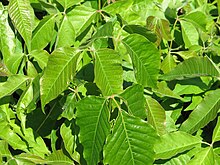Our website is made possible by displaying online advertisements to our visitors.
Please consider supporting us by disabling your ad blocker.
Toxicodendron radicans
| Toxicodendron radicans | |
|---|---|

| |
| During autumn | |

| |
| In spring, Ottawa, Ontario | |
| Scientific classification | |
| Kingdom: | Plantae |
| Clade: | Tracheophytes |
| Clade: | Angiosperms |
| Clade: | Eudicots |
| Clade: | Rosids |
| Order: | Sapindales |
| Family: | Anacardiaceae |
| Genus: | Toxicodendron |
| Species: | T. radicans
|
| Binomial name | |
| Toxicodendron radicans (L.) Kuntze
| |

| |
| Toxicodendron radicans range map in the United States and Canada | |
| Synonyms | |
| |
Toxicodendron radicans, commonly known as eastern poison ivy[3] or poison ivy, is a species of allergenic flowering plant. It has numerous subtaxons and forms both vines and shrubs. Despite its common name, it is not a true ivy, but rather a member of the cashew and pistachio family Anacardiaceae. It is different from western poison ivy, Toxicodendron rydbergii, and resembles a number of species.
The species is found in North America. Although commonly eaten by animals, with birds consuming the seeds, T. radicans is considered a noxious weed. As a poison ivy, if causes urushiol-induced contact dermatitis in most people who touch it, producing an itchy, irritating, and sometimes painful rash.
- ^ Bárrios, S. & Copeland, A. (2021). "Toxicodendron radicans". IUCN Red List of Threatened Species. 2021: e.T124270453A192137361. doi:10.2305/IUCN.UK.2021-3.RLTS.T124270453A192137361.en. Retrieved 26 September 2023.
- ^ NatureServe (1 September 2023). "Toxicodendron radicans". NatureServe Network Biodiversity Location Data accessed through NatureServe Explorer. Arlington, Virginia: NatureServe. Retrieved 26 September 2023.
- ^ NRCS. "Toxicodendron radicans". PLANTS Database. United States Department of Agriculture (USDA). Retrieved 11 December 2015.
Previous Page Next Page




